-
收藏模板
- 模板信息
- 更新时间:2023-09-22
- 字数:约18157字
- 页数:约10页
- 格式:.doc
- 推荐版本:Office2016及以上版本
- 售价:5 金币
您可能喜欢的文档

人教版高中英语必修1English around the world说课稿
(3)v. 给:提出;展现,显现present sb. with sth. ; present sth. to sb. 把. . 交给;颁发;授予present sth. (for sth. )/present sth. to sb. e. g. Om his birthday, his friends presented him a collection of stamps. 在他生日时,他的朋友们送给他一套邮票作为礼物。The sword was presented by the family to the museum. 这家人把宝剑捐赠给了博物馆。The committee will present the final report to Parliament in June. 委员会将在六月向议会提交最后的报告。You need to present yourself better. 你需要更善于展现自己。It is essential that we present a united front. 至关重要的是我们要表现得更加团结。Step 4 ConsolidationT:Now that we have got a general idea of these words and phrases. Lets make up some sentences using them to master them. Suggested sentences:1. Your duties include typing letters and answering the telephone. 2. It is one of the greatest roles that she has played. 3. A large number of people have applied for the job. 4. The number of the panda is declining. 5. I'11 go there, even if I have to walk. 6. He came up to me to ask for a light. 7. The novel is about a family who can't communicate with each other. 8. He based his plan on interests of most people. 9. Why doesn't he make use of his singing talent?Step 5 Summary and homeworkT:Today we dealt with several new words and phrases. After class I hope that youcan read them again and again to keep them in mind. That's all for today. You aredismissed.
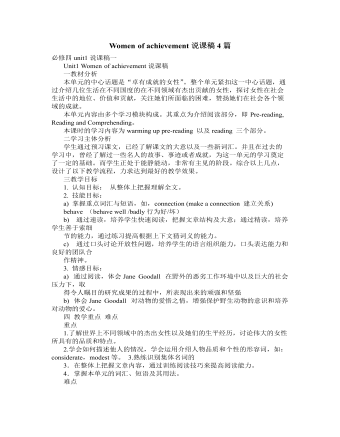
人教版高中英语必修4Women of achievement说课稿4篇
Good morning, distinguished judges:It’s my honor to talk about my teaching ideas with you. Today my topic is Women of Achievement. My presentation consists of six parts: the analysis of teaching material and student, teaching aims, key and difficult points, teaching and studying method, teaching procedures and blackboard design.First, let’s focus on the analysis of teaching material. This lesson is from New Senior English for China Student’s Book 4 Unit 1, the reading part. The main topic of the passage is the introduction of a student of Africanwildlife. After this lesson, the students will learn more information about her studying chimps in Africa, and their reading and speaking abilities can be developed as well.The next part is the analysis of students. My students are in senior high students. They have learnt English for many years, they’ve known many words and sentences, but their speaking and reading abilities are still not very good. So I will practice their speaking and reading abilities through different exercises.According to the New Standard Curriculum and the present situation, I set the teaching aims as follows: firstly, knowledge aims. Students can grasp some new words, such as worthwhile, move off. Moreover, students can understand the content of the passage and get familiar with the topic of studying chimps in wildlife. Secondly, ability aims. Students can use reading strategies such as skimming and scanning in reading process. Thirdly, emotional aims. Students can have the awareness of protecting animals and care about animals.Based on the above analysis, the key point of this lesson is to get the main idea and the detailed information from the passage; the difficult point is to talk about the wildlife protection and use reading strategies.

人教版高中英语必修3Astronomy the science of the stars说课稿3篇
Step 2 Pre-listeningAfter students finish their discussion, I will show a picture of Newton and ask them: Who is him? What is he famous for? Could you find out some words to describe him? Maybe students will answer that he is genius for his finding of theGravitation, making a great contribution to the progress of human being. At that time I will show another two pictures of Einstein and Hawking, letting students guess who they are and write down their idea about the Gravitation. For I have arranged them to search more information about the gravity before this class, Students have beenfamiliar with the topic and will not be afraid about this abstract conception, which is helpful for their listening.Step 3 While-listeningIn this step, students will be required to listen the material for three times. The first and listening is extensive listening and the second and third listening is intensive listening. In the first time, They are required to listen a material including Part 1 and Part 2 and choose the best summary of the listening text. After they choose the right answer, They also need work in group to explain what is wrong with the others. Then I will make a conclusion that we should pay attention to the first paragraph and last paragraph and some keys to get the main idea. By doing this, their capacity of generalization will have a great improvement.Before the second listening, I will ask students to scan the blank on the power point quickly and ask them to note down some key words .Then ask them to listen to the Part 1again and fill the first column of the chart. Maybe some students just show the ideas of these three scientists an still can’t catch their development of gravity. Therefore, I will ask them to listen to Part 2 again and fill in the rest. After finish the listening, I will give them ten minutes to discuss with their partner. I will also guidethem to improve their answers when they discuss with others.
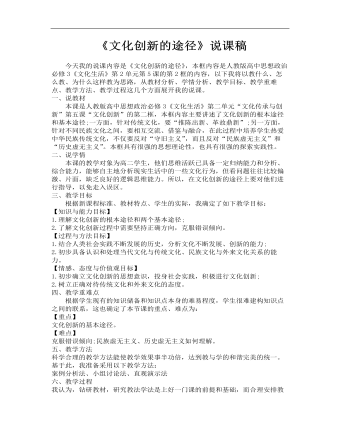
高中思想政治人教版必修三《文化创新的途径》说课稿
二、说学情本课的教学对象为高二学生,他们思维活跃已具备一定归纳能力和分析、综合能力,能够自主地分析现实生活中的一些文化行为,但看问题往往比较偏激、片面,缺乏良好的逻辑思维能力。所以,在文化创新的途径上要对他们进行指导,以免走入误区。三、教学目标根据新课程标准、教材特点、学生的实际,我确定了如下教学目标:【知识与能力目标】1.理解文化创新的根本途径和两个基本途径;2.了解文化创新过程中需要坚持正确方向,克服错误倾向。
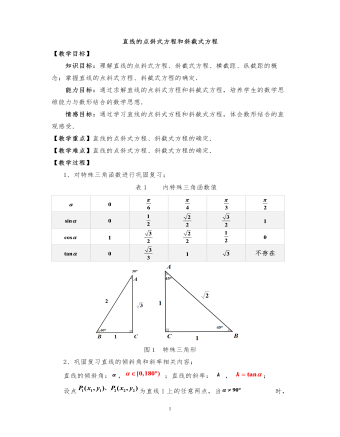
高中数学人教版必修二直线的点斜式方程教案
【教学目标】知识目标:理解直线的点斜式方程、斜截式方程、横截距、纵截距的概念;掌握直线的点斜式方程、斜截式方程的确定.能力目标:通过求解直线的点斜式方程和斜截式方程,培养学生的数学思维能力与数形结合的数学思想.情感目标:通过学习直线的点斜式方程和斜截式方程,体会数形结合的直观感受.【教学重点】直线的点斜式方程、斜截式方程的确定.【教学难点】直线的点斜式方程、斜截式方程的确定.
- 查看更多相关Word文档
A taste of English Humor说课稿3篇
必修四unit3说课稿一
Unit 3 Book 4
A taste of English Humor
Part one : Understanding of the lesson
本课选自人民教育出版社出版的普通高中课程标准实验教材,高一年级必修四的第三单元A taste of English humour。

A. The analysis of the teaching material
The purpose of this reading is tointroduce the life and work of Charlie Chaplin and the kind of humour we canall laugh at --- nonverbal humour.
This lesson is designed as a readinglesson. According to the new curriculum
standards of senior high school English,students are expected to achieve the skills of a. understanding the main idea;b. scanning for the needed information; c. grasping the details; d. guessingthe meaning of new words; e. understanding the intension and attitude of theauthor and f. understanding the background and culture information.
B. Teaching Aims:
a. Enable students to learn what humormeans and what is nonverbal humor.
b. Students are expected to improve thereading skills, ie, skimming and scanning skills as well as translating ,interpreting and word guessing abilities, which are examined in recent years inNMET.
By learning the passage, students willknow that humour is particular to each culture. So the English humour iscertainly different from Chinese humour. However , there is a kind of humourthat may be enjoyed by all cultures --- that is nonverbal humour. It is goodthat we can all laugh at something together.
a. self-learning and cooperative learningmethods; and use such kind of ability to gain and deal with languageinformation.
b. develop the students’ questioning spirit to improve theirability of finding,
analyzing and solving problems.
C. Teaching methods:
a. Task-based Language Teaching :
During the course, different tasks aredesigned for Ss to carry out. Whether and how they finish the tasks can reflecton how much information they grasp from reading. In return, the teacher canadjust his/her teaching.
b. Cooperative Learning:
Divide the class into small teams, eachwith students of different levels of ability.
Every member of a team is responsible notonly for learning what is taught but also for helping teammates learn, thuscreating an atmosphere of achievement.
D. Important and difficult points.
a. Help students learn how to understandand enjoy English humors.
b. Help students know the differencesbetween English and Chinese in humor.
E. Teaching aids:
Multi-media
pictures
blackboard
Part Two:Teaching procedures:
Step one: Lead-in and Warming up( 5 mins)
In order for students to get into thetopic of humor quickly and smoothly, a piece
of sketch video “Eating noodles”by Chen Peisi will be played for thestudents.
Question: Do you know who the Chinesecomedian is ?( Chen Peisi)
What makes his performance funny? ( hisbody gestures)
Then show some pictures of Charlie Chaplinto students.
Questions: Do you know who he is ?
What do you know about Charle Chaplin?
What do you expect to learn about fromthis reading? ( students’ answers
may vary)
(简评:这一环节的设计将会激发学生对文章中这一话题的兴趣并能引起让学生
在短时间内集中精力,这对于学生完成下面的阅读任务很有帮助。)
Step Two: Reading ( 22 mins)
Fast Reading ( Skimming) (7 mins)
Task 1: Fast Reading (3 mins)
What’s the passage mainly about?
C. Because he is always made fun of byothers.
D. Because of his optimism anddetermination fo overcome all difficulties.
3. Find a sentence in the passage similarin meaning to the following one:
Charlie’s real life was not so comfortable as itwas showed in his films.
4. Translate the sentence into Chinese “You may find it astonishing that Charliewas taught to sing as soon as he could speak and dance as soon as he could walk”. 5. Guess the meaning of the word “convincing” in line 30 Page 18.
(简评:这一环节沿用了英语阅读教学中最重要的两种阅读技能,即略读和查读。这也是本课设计的重点。同时,在查读这一环节的任务2中,我设计了高考新题型的相关练习,如翻译,替换句子等等,这样就有效地把高考和日常教学联系了起来,也促进了学生应答这种练习的能力。)
Step Three : Retelling (5 mins)
People may laugh at others_______ on abanana skin, or falling down a hole, for it makes them _______ with themselvesseeing others _______ _______ than
themselves.
As an outstanding humourous actor, Chaplincould always _______ in the people deep feelings by using _________ forms ofacting in the time of silent films. His charming _________ “the little tramp” is well-known all over the world, a poorand _________ person wearing large trousers, ________ shoes, and carrying awalking _______.
A social _______ as he was, he was lovedby all the people for his ____________ in overcoming difficulties and beingkind to people _______ to him. When playing the famous film The Gold Rush,Chaplin managed to make the sad situation—eating a _______ shoe, entertaining byusing __________ humour.
Such is Charlie Chaplin who produced,_______ , and wrote the movies that he _______ in. He was given a special Oscarfor his lifetime work ____________ of bringing humour to us all.
(简评:这一环节是一巩固练习,使得学生对文章中的既得信息有所加强,并对这篇文章有了更加整体的理解。)
Step Four: Pair work. ( Enjoying 4 mins)
Part 1:
JOKE 1
Wife talking to her husband (who readsnewspaper all day): I wish I were a
newspaper so Ill be in your hands allday.
Husband: I wish that too, so I couldchange you daily
JOKE 2
TOMS EXCUSE
Teacher: Tom, why are you late for schoolevery day?
Tom: Every time I come to the corner, asign says, "School-Go Slow".
Part 2:
Show the students some pictures ofnonverbal homour to let them
appreciate . (omitted)
Step Five : Interview ( Group activity8mins)
The students are divided into groups of 4. Then in each group students will take their turns to be Charlie and the other3 act as reporters to interview him/her using the information from the reading.
(简评:这两个环节是为了知识转化/过渡, 即让学生切实体会到nonverbal
humour is really universal, 又给了学生练习口语的机会,同时也体现了本课时的情感目的。)
Step Six : Home work
Find more information about Chaplinthrough The Internet or from books and you are expected to present it to yourclassmates in the next class.
(简评:这是这节课的综合落实环节)
课后反思:
本节课主要训练阅读技能,兼顾听、说和译等技能的培养。在具体实施过程中采用了任务型教学法,体现了因材施教原则和以学生为主体的教学原则,通过师生的共同努力与配合,圆满完成了教学任务,提高了学生的阅读能力,同时通过小组讨论,增强了学生的合作意识。此期间也出现了一些问题,如内容太多,时间仓促,致使个别环节处理非常不太恰当,用时太少,而没有完全达到预期的效果。另外,在上课中有时让学生按部就班地跟着老师的思路走,而忽视了他们的主体地位和主观能动性,从而限制了学生的思维。另外,学生的学习积极性还没有完全调动起来,这一点也是以后的教学中需要特别注意的。总之,教与学两个环节中,应把重点放在学生身上,老师的教是为学生的学服务的。
必修四unit3说课稿二
Unit3 A taste of English humor
一、说教材
1、说教材的地位和作用
我这节课的内容是人教版高中英语必修四第三单元A taste of English humor的Warming-up和Reading部分。本单元是关于不同类别的英式幽默,通过学习本单元,能够让学生了解Charlie Chaplin滑稽但是却鼓舞人心的幽默,This reading material tells us the storyabout the master of nonverbal humor, Chalie Chaplin, including his life story,his achievements in film making, and his great performance in Gold Rush.本单元阅读部分不但能让学生了解到关于Charlie Chaplin的相关信息,同时也能够让学生通过本篇课文,提高英语学习的能力。
The central topic of this unit is “humor”. Humor has two meanings. Firstly, itrefers to the quality in something that makes it funny and makes people laugh.Secondly, it refers to the ability to think that things are funny, or funny thingsyou say that show you have this ability. Through the study of this unit, theteacher will let the students realize that there are many different ways tounderstand and express humor because of cultural difference, and this maysometimes cause misunderstandings. What is more, it is hoped that the studentscan get an optimistic attitude towards life after learning this unit.
2、教学目标
众所周知,阅读在英语学习的过程中属于语言的输入过程,而语言的输入过程又对语言的输出过程,比如说和写又有很大的作用,那么,在研究完新课程标准和教学大纲后,我的教学目标将会是知识目标、能力目标、情感目标。
(1)知识目标学生能够听懂,读懂,并且能够正确地使用文中重点的单词,短语重点单词:humor content astonishing unfortunatelyordinary bored entertain throughout homeless worn failure overcome leather chewconvince convincing direct outstanding 重点短语:up to now, badly off, pick out, cut off,star in 学生能够理解文章的内容。
(2)能力目标增强学生的听,说,读,写能力,尤其是说和写的能力训练学生共同协作的能力增强学生阅读能力,尤其是跳读和精读的能力。
(3)情感目标通过本文,学生能够从Charlie Chaplin那学到乐观面对生活的苦难,并且能够自己去发掘我们生活中的幽默。Enable the students to learn what humormeans and what is nonverbal humor. Help students to learn the Subjunctive Mood.
3、教学重点和难点
重点:帮助学生了解重点单词及短语的用法,提高学生的阅读能力。难点:帮助学生理解中式和英式幽默的区别。
二、说学情
高中年级的学生已经在初中阶段的英语学习中,已经积累了一定的词汇基础,并掌握了一些简单的学习策略和技巧,具有初步的英语听说读写能力。但是,学生个性和英语水平差异大,因此教学设计要有梯度,由浅入深,注意层次性。
英语作为一门语言,其最基本的作用就是人际交流。这个阶段的学生思维非常敏捷,并且他们也非常渴望展示自己,而他们自身也存在着一定的阅读能力,但是他们缺少相应的外国文化背景以及表达自己思想的勇气,因此我在课堂要鼓励学生们搜集资料了解外国文化同时利用每个机会开口说英语,以达到锻炼口语的目的。
三、说教法和学法
1.教法:①任务教学法:结合学生的生活经验和兴趣设计相当的任务值,让学生在完成任务的过程中学习到应有的知识并提高语言的沟通能力。同时让学生带着问题去阅读,找出相关答案,并分析整理形成自己的观点。
②情景教学法:通过举例以及观看相关视频和图片让学生了解以卓别林为代表的英式幽默和中式幽默的区别并谈谈自己的感受。
2.学法:虽然这个阶段的学生具有一定的阅读能力,但是由于文化差异,学生可能难以理解外国式的幽默,所以老师可以引导学生在原有的知识经验基础上通过合作探究学习构建新的知识经验和信息输入。
四、说教学过程
Step I: Lead-in and Warming up (5 mins)
Firstly, the students will be asked toread the two jokes on Page 17. 问学生课文17页的笑话。Then, the teacher will guide the studentsto get farmiliar with different types of English humor by the chart.然后引导学生进一步了解英式幽默。
Next, the students are encouraged to thinkabout the other types of humor and the types of Chinese humor. (sketch, crosstalk, funny stories and so on)鼓励学生说出自己指导的一些有趣的中文和英文幽默故事来比较两者的区别。
设计意图:用问题的方式引入本节课的话题,引发学生思考。
Step II: Pre-reading (5 mins)
The teacher will show the students somepictures of Charlie Chaplin. And then let the students to say anything theyknow about him. 我会给学生展示卓别林的相关图片,然后让学生说出他们对卓别林的了解。Let the students see the title of thereading material and ask them to guess what the text is about. 让学生根据课文的题目先预测课文的内容。
设计意图:引起学生的兴趣,激发他们阅读的兴趣和欲望。
Step III: Fast reading (5 mins)
Ask the students to read the text quicklyin three minutes and then finish Exercise 1 on Page 19. 让学生进行三分中快速阅读和完成课文19页的题目。
设计意图:这一环节沿用了英语阅读教学中重要的阅读技能之一,即快速阅读。可以让学生对课文有一个大致的了解。
Step IV: Explanation (10 mins)
The teacher will explain the importantlanguage points in the text. 解释课文中出现的重点词汇和知识点。Then the students will be asked to work ingroups to summarize the main idea of each paragraph. (Exercise 2 on Page 19)让学生分组进行总结归纳文章的段落内容。
设计意图:让学生掌握课文中的重点词汇和句子,加深对课文的理解。 Step V: Listening and Discussion (10mins)
Listen to the tape of the text and then ingroup, ask the students to have a discussion about Charlie Chaplin。让学生听一遍全文,展开有关卓别林的讨论。
1. Do you think his poor childhood helpedhim in his work? Why? 你认为艰苦的童年是否对卓别林的成功有帮助?为什么这么认为?
2. Why do you think he was so successful? 你认为卓别林成功的原因是什么?
3. What can we learn from him? 从卓别林身上可以学到什么?
设计意图:用问题的方式加深学生对阅读内容的理解,同时可以很好的锻炼学生的口语表达能力。
Step VI: Interview and Homework ( Groupactivity) (10 mins)
The students are divided into groups of 4. Then in each group students will take their turns to be Charlie and the other3 act as reporters to interview him/her using the information from the reading.
(简评:这两个环节是为了知识转化/过渡, 即让学生切实体会到nonverbal humour is really universal, 又给了学生练习口语的机会,同时也体现了本课时的情感目的。Find more information about Chaplinthrough The Internet or from books and you are expected to present it to yourclassmates in the next class.
(简评:这是这节课的综合落实环节)
五、板书设计
必修四uni3说课稿三
Good morning/afternoon, everyone! Im veryglad to stand here to interpret my lesson. Today my topic is “A taste of English humor” (writing part). I am going to introducemy lesson from the following aspects: the
analysis of teaching material andstudents, teaching aims, teaching key points and different points, teaching andstudying methods, teaching procedures and blackboard design.
Ⅰ. Analysis of the teaching material
First of all, let’s focus on the analysis of teachingmaterial. This unit is about humor in English. Writing part consists of threesections: section 1 is a speaking activity. Actually it has two stages: adiscussion and a story telling. They can used as a preparation for writing.Section 2 includes some guidance for writing and they are in time-order. Thesection 3 has a sample writing and the format for each part.
Ⅱ. Analysis of the students
Then, I’d like to talk something about thestudents. Funny story is a very interesting topic and related to their dailylife. However, many language
learners face a big challenge in writing,especially on the aspect of grammar or logic order, so do my students. Theywill easily get frustrated and bored if teacher doesn’t guide them in a right way.
Ⅲ. Analysis of the teaching aim
Based on the syllabus and the analysis, Iset the teaching aims as follows: Knowledge aims: Students will learn somebasic knowledge about story writing, including its format: the situation, whathappens, and the punchline
Ability aims: Students can develop theirlogical thinking ability through writing and their The ability of creatingfunny stories from their real life can be trained.
Emotional aims: Students can form apositive attitude towards life and the sense of humor. And they could enjoy thesuccess in writing.
Ⅳ. Analysis of the key and difficult points
According to the teaching aims, both thekey point and the difficult points of this lesson are leading students to findsome basic knowledge about story writing, including its format: the situation,what happens, and the punchline.
Ⅴ. Analysis of teaching and study methods
To help students achieve the teaching aimsmuch easier, I will mainly use process writing task-based teaching method,multimedia method and communicative teaching method and so on. For students, Iwill encourage them to learn to communicate with their classmates to let thembecome the real leading role of the class.
Ⅵ. Analysis of the teaching procedures
Pre-writing:
In the beginning, I would tell them thepurpose of this lesson. Then I would tell them a typical funny story and Iwould obverse their reaction when listen to the story.
In fact, that story is very traditionaland some of them would not be interested in it because they heard a lot storieslike that in the recent week. The purpose is make the next stage much easier.
After listening, I would ask them to do adiscussion about what the story: Do they like it, why. And the words andexpressions in the textbook can be used in their discussion.
This speaking activity can lead studentsto think about how to think out a funny story. It is good for their writing.And in the ending period of this unit, we use a speaking activity for warming-upis suitable.
转载请注明出处!本文地址:
https://www.lfppt.com/worddetails_57202148.html最新说课稿文档
-
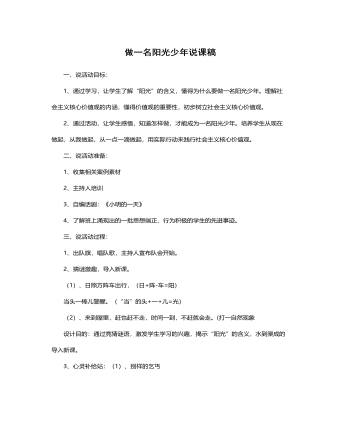
做一名阳光少年说课稿
1、紧密联系学生的生活实际,所选材料、所有活动均本着为主题服务的原则。2、形式多样化。通过心灵补给站、我来当编剧、心动不如行动等丰富多彩的活动,激发学生的热情,充分发挥他们的主体性。3、用生活中的真人真事激励他们,震撼他们的心灵,对学生进行教育,让他们得到感悟。五、说评价方式:要真正发挥主题队会的教育作用,千万不能把主题队会开成“检讨会”、“批评会”。兴趣是最好的老师,在课堂上,学生有了兴趣,才会有学习的动机,所以,在教学过程中,我努力把学生当作一个平等的朋友来对待,对于学生的回答进行评价时,本着“多表扬少批评,多鼓励少指责”的原则,尽量不用指令性、批评性的语言,最大限度的挖掘学生的优点,进行激烈性评价。

追思先烈魂,弘扬爱国情说课稿
环节四深入实践——弘扬爱国情爱国不是一句口号,要将爱国情怀落实到行动中去,队员们在各队队长的组织下,商讨出了落实方案。1、第一小队和第二小队组成了先烈故事演讲团,利用班会十分钟的时间,在三四年级宣讲先烈故事。2、第三小队和第四小队组成了创编小能手,编唱了爱国童谣、爱国拍手歌,告诉大家,爱国无处不在,爱国要从小事做起。3、第五小队和第六小队编写的爱国倡议书,提倡大家让爱国从口号落实到行动。4、全体队员共同宣誓:时刻准备着,为共产主义事业而奋斗,将活动推向了高潮。环节五大队辅导员总结“风雨沧桑,多遭铁蹄践踏,未有沉沦终奋起;荡涤污浊,重聚华夏精魂,披荆斩棘勇向前。”让我们牢记自己是中国人,怀一颗中国心,明确方向,努力奋斗,早日实现自己的梦想。
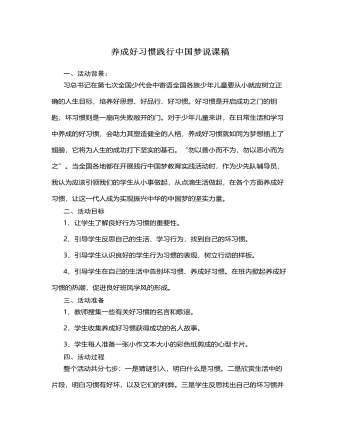
养成好习惯践行中国梦说课稿
第七步:全班学生一起倡读承诺书:(课件出示)我们都是小学生,培养习惯最要紧;上课应当专心听,积极开动小脑筋;作业认真仔细做,按时完成交得勤;有了错误要订正,知识才能学得清;人生要有好习惯,我们牢牢记心上。最后请学生把自己要养成的好习惯写在心意卡上,写好后粘贴在教室后面的园地里,互相督促,使得此次活动教育延续课后,直至影响一生.5、活动效果及反思此次活动开展后,学生们增强了对自身的认识,很多学生下决心改掉自身的坏习惯,并逐步采取了实际行动,从身边的小事做起,而且在学生中间还兴起了互相帮助、互相指正、争相进步的热潮。通过此次活动我也切实的体会到养成教育要开展就要落到实处,从实际出发,让学生亲自去感受,去体会,并且要持之以恒的做下去。同时作为老师更应该有一颗敏感热情的心,随时发现学生身上的闪光点与不足,多指正、多指点、多鼓励、多表扬,做到时时处处皆教育,这样才能赢得孩子,做好教育。
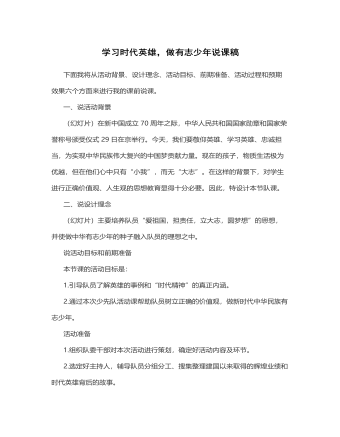
学习时代英雄,做有志少年说课稿
一、说活动背景(幻灯片)在新中国成立70周年之际,中华人民共和国国家勋章和国家荣誉称号颁受仪式29日在京举行。今天,我们要敬仰英雄、学习英雄、忠诚担当,为实现中华民族伟大复兴的中国梦贡献力量。现在的孩子,物质生活极为优越,但在他们心中只有“小我”,而无“大志”。在这样的背景下,对学生进行正确价值观、人生观的思想教育显得十分必要。因此,特设计本节队课。二、说设计理念(幻灯片)主要培养队员“爱祖国,担责任,立大志,圆梦想”的思想,并使做中华有志少年的种子融入队员的理想之中。说活动目标和前期准备本节课的活动目标是:1.引导队员了解英雄的事例和“时代精神”的真正内涵。2.通过本次少先队活动课帮助队员树立正确的价值观,做新时代中华民族有志少年。
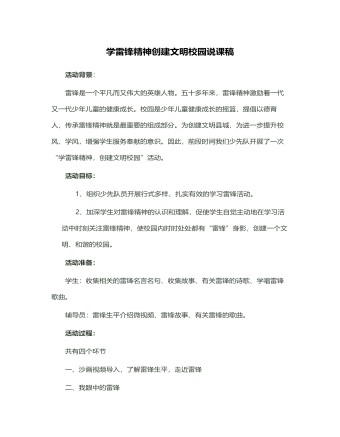
学雷锋精神,创建文明校园说课稿
雷锋精神是什么?这一环节是让学生用简单的词语或句子概括。通过这一活动,让学生概括出雷锋精神的内涵:像无私奉献、乐于助人、为人民服务、勤俭节约、尊老爱幼、勤奋好学、干一行爱一行、言行一致等等都是雷锋精神的体现。我们少年儿童是中国的未来和希望,雷锋精神的发扬和光大,创建文明校园的任务就落在他们的肩上,所以在这里我还设计了为发扬雷锋精神,创建文明校园“我该怎么做”这样的问题,目的就是让他们一起行动起来,学雷锋做好事,并制作了“荣誉”旗,奖励身边的好人好事。活动延伸:这里我设计了一个角色游戏活动——我要义卖献爱心,这个游戏学生们表现得非常积极,他们收集了自己不要的小文具或小玩具,将他们拿到集市上去卖,卖东西获得的钱,捐给王奶奶的孙女,因为王奶奶的孙女生病了,无钱治病。我觉得这个游戏使学生们懂得,一个人只要有爱心,只要愿意去帮助别人,无论什么方式都行,而且在游戏活动中孩子们体会到了帮助别人是一件多么多么快乐的事呀。
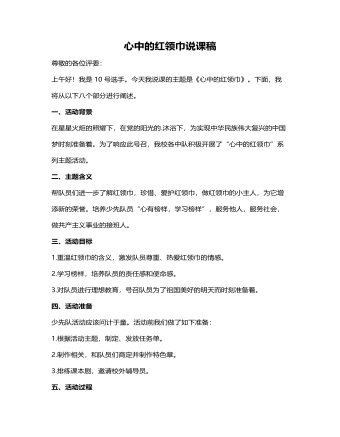
心中的红领巾说课稿
1.学习“最美红领巾”。图文结合,学习“美德少年”刘华婷、刘颖等人的先进事迹。2.记录“平凡红领巾”。展示队员们活动前精心准备的“随手拍”,发现普通队员在日常生活中的闪光点。3.填写“我为红领巾添光彩”心愿卡,对学生进行理想教育。4.齐唱《红领巾之歌》,点燃信念火种。5.辅导员对此次活动进行总结,并颁发特色章。(出示三个特色章图标)六、活动延伸红领巾精神需要代代相传,珍爱红领巾的意识需要时时提醒,本次活动后,我们会开展“小小新四军”、“鲜艳的红领巾”等后续活动,帮助队员们将红领巾精神永远铭记在心。七、引导要点四年级队员具备一定的活动能力和经验,通过课本剧的亲身体验、心愿卡的真情表达等多种方式的运用,引导队员热爱红领巾,以红领巾精神指引自己健康成长。八、活动评价本次活动,队员们受到了良好的教育。但是四年级队员自我约束能力不够强,缺乏持久性,萌生的意识和激情往往只停留在活动时,不能在活动后内化为自觉行为,这些问题有待探究。
今日更新Word
-

精选高中生期末评语
1、该生学习态度端正 ,能够积极配合老师 ,善于调动课堂气氛。 能够积极完成老师布置的任务。学习劲头足,听课又专注 ,做事更认 真 ,你是同学们学习的榜样。但是,成绩只代表昨天,并不能说明你 明天就一定也很优秀。所以,每个人都应该把成绩当作自己腾飞的起 点。2、 你不爱说话 ,但勤奋好学,诚实可爱;你做事踏实、认真、为 人忠厚 ,是一个品行端正、有上进心、有良好的道德修养的好学生。在学习上,积极、主动,能按时完成老师布置的作业,经过努力 ,各 科成绩都有明显进步,你有较强的思维能力和学习领悟力,学习也有 计划性,但在老师看来,你的潜力还没有完全发挥出来,学习上还要有持久的恒心和顽强的毅力。
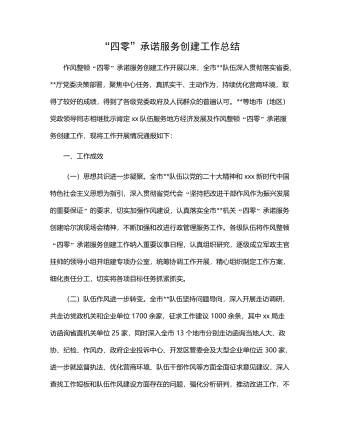
“四零”承诺服务创建工作总结
(二)坚持问题导向,持续改进工作。要继续在提高工作效率和服务质量上下功夫,积极学习借鉴其他部门及xx关于“四零”承诺服务创建工作的先进经验,同时主动查找并着力解决困扰企业和群众办事创业的难点问题。要进一步探索创新,继续优化工作流程,精简审批程序,缩短办事路径,压缩办理时限,深化政务公开,努力为企业当好“保姆”,为群众提供便利,不断适应新时代人民群众对政务服务的新需求。(三)深化内外宣传,树立良好形象。要深入挖掘并及时总结作风整顿“四零”承诺服务创建工作中形成的典型经验做法,进一步强化内部宣传与工作交流,推动全市创建工作质效整体提升。要面向社会和公众庄严承诺并积极践诺,主动接受监督,同时要依托电台、电视台、报纸及微信、微博等各类媒体大力宣传xx队伍作风整顿“四零”承诺服务创建工作成果,不断扩大社会知情面和群众知晓率。
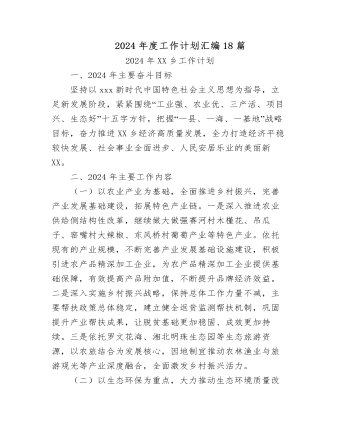
2024年度工作计划汇编(18篇)
1.市政基础设施项目5项,总建设里程2.13km,投资概算2.28亿元。其中,烔炀大道(涉铁)工程施工单位已进场,项目部基本建成,正在办理临时用地、用电及用水等相关工作;中铁佰和佰乐(巢湖)二期10KV外线工程已签订施工合同;黄麓镇健康路、纬四路新建工程均已完成清单初稿编制,亟需黄麓镇完成图审工作和健康路新建工程的前期证件办理;公安学院配套道路项目在黄麓镇完成围墙建设后即可进场施工。2.公益性建设项目6项,总建筑面积15.62万㎡,投资概算10.41亿元。其中,居巢区职业教育中心新建工程、巢湖市世纪新都小学扩建工程已完成施工、监理招标挂网,2月上旬完成全部招标工作;合肥职业技术学院大维修三期已完成招标工作,近期签订施工合同后组织进场施工;半汤疗养院净化和医用气体工程已完成招标工作;半汤疗养院智能化工程因投诉暂时中止;巢湖市中医院(中西医结合医院)新建工程正在按照既定计划推进,预计4月中下旬挂网招标。

驻村工作队2024年第一季度工作总结汇编(4篇)
三是做大做强海产品自主品牌。工作队于xx年指导成立的冬松村海产品合作社,通过与消费帮扶平台合作,在工作队各派出单位、社会团体、个人支持下,已获得逾xx万元销售额。2022年底工作队推动合作社海产品加工点扩建的工作方案已获批,待资金下拨后将正式启动扩建工作。四是积极助企纾困,带动群众增收致富。工作队利用去年建立的xx镇产业发展工作群,收集本地企业在产品销售、技术、人力、资金、运营、用地等方面的需求,并加大xx支持乡村振兴力度,xx助理赴各村委开展多场xx政策支持乡村振兴宣讲活动,本季度有x万元助农贷款获批,xx万贷款正在审批中。在壮大既有产业的同时,完善联农带农机制,一方面鼓励企业雇用本地农户就业,另一方面计划与本地农户签订长期收购合同,让农民种得放心、种得安心,带动当地群众共同致富。

主题教育总结常用提纲大全
第一,主题教育是一次思想作风的深刻洗礼,初心传统进一步得到回归。第二,主题教育是一次沉疴积弊的集中清扫,突出问题进一步得到整治。第三,主题教育是一次强化为民服务的生动实践,赤子之情进一步得到提振。第四,主题教育是一次激发创业担当的有利契机,发展层次进一步得到提升。2.第一,必须提领思想、武装思想。第二,必须聚焦问题、由表及里。第三,必须领导带头、以上率下。第四,必须务实求实、认真较真。3.一是抬高政治站位,坚持大事大抓。二是坚持思想领先,狠抓学习教育。三是突出问题导向,深入整改纠治。四是坚持领导带头,发挥表率作用。4.一是立足“早”字抓筹划。二是着眼“活”字抓学习。三是围绕“统”字抓协调。5.一是形势所需。二是任务所系。三是职责所在。四是制度所定。6.一要提升认识。二要积极作为。三要密切协作。
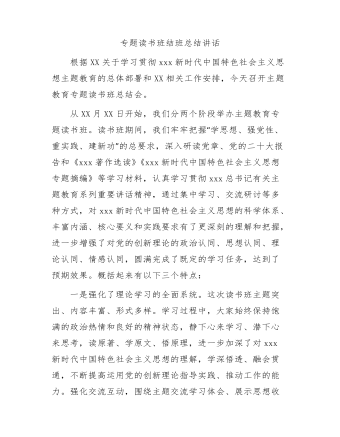
主题教育专题读书班结班总结讲话
第二,要把调查研究贯穿始终,实干担当促进发展。开展好“察实情、出实招”“破难题、促发展”“办实事、解民忧”专项行动,以强化理论学习指导发展实践,以深化调查研究推动解决发展难题。领导班子成员要每人牵头XX个课题开展调查研究,XX月底前召开调研成果交流会,集思广益研究对策措施。各部门、各单位要制定调研计划,通过座谈访谈、问卷调查、统计分析等方式开展调查研究,解决工作实际问题,帮助基层单位和客户解决实际困难。第三,要把检视问题贯穿始终,廉洁奉公树立新风。认真落实公司主题教育整改整治工作方案要求,坚持边学习、边对照、边检视、边整改,对标对表xxx新时代中国特色社会主义思想,深入查摆不足,系统梳理调查研究发现的问题、推动发展遇到的问题、群众反映强烈的问题,结合巡视巡察、审计和内外部监督检查发现的问题,形成问题清单。


















